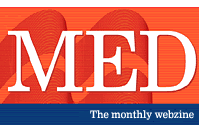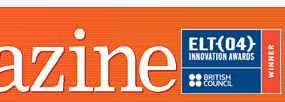|

FROM THE EDITOR
 In
this Issue In
this Issue
 Contributors Contributors
 Letters
to the Editor Letters
to the Editor
 Write
to Us Write
to Us
 Spread
the Word Spread
the Word
 Back
Issues Back
Issues
 Index Index
FEATURE
 Issues
in Business Issues
in Business
English teaching
Learner independence
in Business English
 Birthday
Greetings Birthday
Greetings
Happy birthday
MED Magazine!
COLUMNS
 Language
Interference Language
Interference
Making friends with Polish
True friends, false friends, unreliable friends and
friends in disguise
 Focus
on Language Focus
on Language
Study:
Introduction
Word formation
Compounds and acronyms
UK
version ¦ US
version
 New
words of the year New
words of the year
A review of 2004
in twelve words
 Top
Tips for Business English Top
Tips for Business English
Teaching presentation skills:
Presentation Essentials 2
Activities ¦
Teacher's notes
 onestopenglish.com onestopenglish.com
|
 |
Top
Tips for Business English
by Rosemary
Richey
Teacher's notes
> Main article
> Activities
To build vocabulary related to organising an effective
presentation.
The activities are aimed at students at upper intermediate to advanced
levels. They are appropriate for one-to-one or group lessons.
Plan for about 60 minutes for the activities. The time
you'll need will depend on the size of your class, and if it's set up
as pair or group work, or as a one-to-one practice. Students need copies
of the Macmillan English Dictionary (MED). Teachers will need at
least a flipchart or whiteboard, and ideally an OHP/OHTs.
 Activities 1 and 2
Activities 1 and 2
| Review the stages of a presentation with a 10 minute
discussion. For more about this, see the top tips article in this
issue and the last
issue of MED Magazine. |
| Go over the introduction with the students, and then
ask them to read the true and false sentences talking about presentations
individually. |
| Organise students in pairs or groups and ask them
to do activity 2 using the MED. |
| Check the answers by each pair or group contributing
their findings, and then give out handouts with the answers. |
Answers for activity 1
T
F T
T F
T T
F F
Example answers for activity 2
| part of a country's economic or business activity |
| a plan to do something |
| to agree on a purchase or contract |
| to give the main ideas without giving the details |
| simple, clear and easy to understand |
| clear to almost anyone |
| to start discussing a subject |
| information you discover after doing research |
| detailed study of something in order to discover
new facts |
| a report containing all the latest information |
| a way of talking that is boring because your voice
does not change in loudness or become higher or lower |
| listening to or watching carefully |
| to trust someone or something/depend on |
| to record something in writing, or to provide evidence
in writing |
Activities 3 and 4
| Students do the activities in pairs and each student
compares answers with a different partner. |
| To check the answers with the whole class, elicit
word forms for the sentences. Put up an OHT with the correct answers. |
Example answers to activity 3
| attentive (adj), attentively (adv), attention (n)
|
| to document (v), document (n), documentation (n) |
| intention (n), intentional (adj), unintentional (adj),
intentionally (adv), unintentionally (adv) |
| obvious (adj), obviously (adv), obviousness (n) |
| to rely on (v), reliable (adj), reliability (n),
unreliable (adj), reliance (n), reliably (adv), reliant (adj) |
| research (n), to research (v), researcher (n) |
| transparent (adj), transparently (adv), transparency
(n) |
Answers to activity 4
| transparent |
intention |
| findings/research |
sector |
| unreliable |
make a deal with |
| attentively |
documented |
Follow-up
| In this worksheet, engineering is mentioned as one
of the business sectors that relies on presentations for project management
and for presenting research data. Have students think of 2-3 other
example sectors with similar aims for presentations, such as fields
within science or medicine. |
| Review the steps for finishing
up a presentation. Have students come up with a particular list
of points for presentations in technical fields. What is the best
way to present figures or data? What kind of visual aids would be
suitable for describing a progress report on an engineering project?
Should the presentation be a lecture style? Why or why not? |
| For this set of lexis, you can get your students
to explore many interesting collocations in the dictionary. Here are
a couple of examples to give students more dictionary work practice.
For each example students write sample sentences and compare with
a partner. |
attention
to pay attention undivided/full attention attention
span
attentive to attend to hold/keep sy's
attention |
research
to carry out research to undertake research
to do research |
Hints and tips
| Check the answers to the activities yourself in MED
with both the CD and the dictionary. |
| Practise with as many realistic examples from the
students' experience as necessary for them to understand the language
used in a presentation context. |
|





